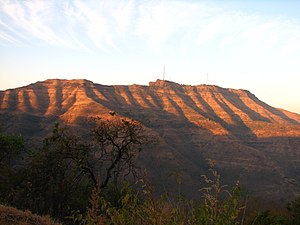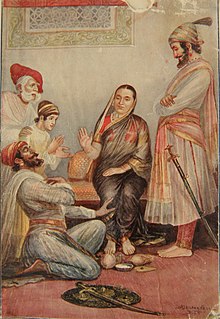Battle of Sinhagad
| Battle of Sinhagad (Kondhana) | |||||||||
|---|---|---|---|---|---|---|---|---|---|
| Part of The Maratha rebellion | |||||||||
 The Fort of Sinhagad | |||||||||
| |||||||||
| Belligerents | |||||||||
|
|
| ||||||||
| Commanders and leaders | |||||||||
|
|
| ||||||||
| Strength | |||||||||
| Unknown | Unknown | ||||||||
The Battle of Sinhagad, also known as Battle of Kondhana, involved an attack by Marathas during the night of 4 February 1670 on the Mughal fort of Sinhagad (then Kondhana), near the city of Pune, Maharashtra. The Marathas captured the fort.
Background
[edit]
In the 1650s, Aurangzeb sent General Shaista Khan to subdue Shivaji. Khan captured Pune and took residence in the Lal Mahal, the childhood residence of Shivaji. In a surprise night attack by Shivaji, Shaista Khan was wounded and one of his sons was killed. However, Khan escaped. In retaliation, Khan looted Pune for 2 years and devastated the Deccan. Shivaji went on to loot and plunder the wealthy port city of Surat to make up for Shaista Khan's looting of Pune. Aurangzeb then sent Maharaja Jai Singh, one of his vassals, with a large army to subdue Shivaji. In his campaign, Jai Singh besieged Purandar fort. Meanwhile, Diler Khan, another Mughal General defeated the Maratha armies at Vajragad and near Purandar. Villages in the Maratha kingdom were also plundered by the Mughal forces. To conserve his strength, Shivaji signed the Treaty of Purandar. According to the treaty, Shivaji was to give 23 forts to the Mughals while retaining control of 12, become a vassal of Aurangzeb.
Later, he agreed to meet Aurangzeb at Agra.[citation needed] However in Agra, Shivaji refused to bow to Aurangzeb. In retaliation, Aurangzeb put Shivaji under house arrest, which Shivaji escaped from by feigning illness. Shivaji then kept a low profile for some years until Aurangzeb turned his focus to campaigns in the Punjab and elsewhere in the North. Jai Singh died at Burhanpur, and a weaker prince, Muazzam, became governor of the Deccan. Shivaji then felt that this was a good opportunity regain lost territory. He broke the treaty and started recapturing the forts from the Mughals.[citation needed]
Battle
[edit]Sinhagad was one of the first forts which Shivaji recaptured from the Mughals. The capture was made possible by scaling the walls at night with rope ladders. Tanaji Malusare was martyred, but the fort was captured by the Marathas. The battle and Tanaji's exploits are the basis of a popular Marathi ballad.[3]
Aftermath
[edit]When Shivaji was informed about the victory and the loss of Tanaji's life during the battle, he is said to have exclaimed "गड आला पण सिंह गेला" (IAST: Gaḍa ālā paṇa siṃha gela English: The fort has been captured but we lost the lion). A bust of Tanaji Malusare was installed at the fort in memory of his contribution and sacrifice.[4]
In popular culture
[edit]- Tanhaji - a Hindi movie of 2020, starring Ajay Devgan, depicted the battle of Kondhana.
- Raja Shivchatrapati - a Marathi TV serial of Star Pravah had episodes about this battle.
- Subhedar - a Marathi movie of 2023, starring Chinmay Mandlekar, depicted the battle of Kondhana
References
[edit]- ^ Sorokhaibam, Jeneet (2013). Chhatrapati Shivaji: The Maratha Warrior and His Campaign. Vij Books India Private Limited. pp. 185–187. ISBN 9789382573494.
{{cite book}}: CS1 maint: date and year (link) - ^ Gordon, Stewart (February 2007). The Marathas 1600-1818. Cambridge University Press. ISBN 978-0-521-03316-9.
- ^ Gordon, Stewart (1993). The Marathas 1600-1818. Vol. 2. Cambridge University Press. p. 79. ISBN 9780521033169.
The first and most spectacular success was the capture of Sinhagad fort. It was taken by scaling very difficult walls by the means of rope ladders in a night raid which culminated in a hand to hand combat inside the fort. The raid was led by Tanhaji Malsure, who was killed in the battle.
- ^ Verma, Amrit (2003). Forts of India. New Delhi: The Director, Publication Division, Ministry of Information and Broadcasting, Government of India. pp. 83–86. ISBN 81-230-1002-8.
